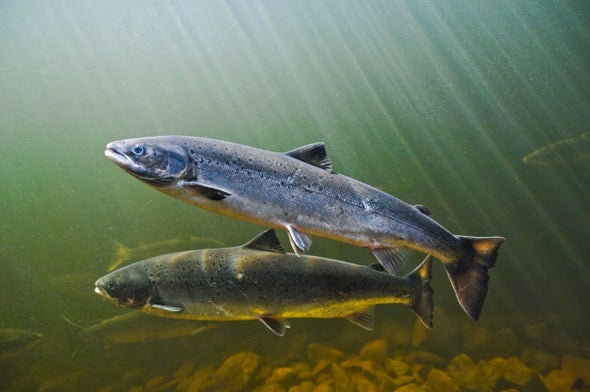CLIMATEWIRE | Atlantic salmon are known for making one of nature’s most remarkable journeys. Each year, hordes of them surge from the ocean into Canada’s rivers and streams, swimming back to their birthplaces to spawn.
Yet fewer of them are returning as time goes on. Fifty years ago, more than a million salmon could be expected each year. Today, scientists estimate only about 400,000 make the annual salmon run.
Canada’s salmon populations have declined for decades for a variety of reasons. Acid rain, overfishing, pollution and damming have all played a role.
And a new threat is gradually emerging. Water temperatures are warming, thanks to a combination of climate change and human water management techniques. And in some places they’re growing hot enough to kill the fish.
“We’ve seen instances where we’ve had die-offs of coldwater species,” said Kathryn Smith, a doctoral candidate in the Coastal Hydrology Lab at Dalhousie University in Canada.
Now, Smith is working on strategies to artificially cool Canada’s rivers and streams. With funding from sources including the Atlantic Salmon Conservation Foundation and the Nova Scotia Salmon Association, where Smith was previously an intern, she’s developed two kinds of techniques.
The first method redirects a portion of a river’s flow through an underground trench, allowing the water to cool off before it flows back into the main stream. It’s a passive technique that cools water temperatures by just a few degrees, giving fish a temporary haven to congregate and cool off.
The second method actively pumps cold groundwater from wells into rivers. In this case, the groundwater can be as much as 20 degrees Celsius cooler than the rest of the river, Smith said.
She’s tested her systems at just a few sites in Nova Scotia. Both methods were effective at cooling the water and attracting fish, although the active system had more dramatic results. She presented her early findings on Oct. 17 in Pittsburgh at an annual conference held by the Geological Society of America.
Next, Smith plans to scale up her experiments and apply them to other sites across the region.
“We’d like to do additional case studies and then compile those results,” she said. The findings could then be presented to scientists, government agencies and water managers with recommendations about how to apply the systems to their own river networks.
It’s important work, said Edmund Halfyard, a senior research scientist with the Nova Scotia Salmon Association.
“We’ve long recognized that temperature is a major player when it comes to Atlantic salmon populations and their viability,” he said.
Salmon tend to be comfortable in water temperatures up to about 20 degrees Celsius (68 degrees Fahrenheit), he said. When temperatures hit 73 F, the fish typically start to search for colder patches of water. And above 80 F or so, they start to die.
Natural rivers and streams tend to wind and meander, and they often contain cooler patches of water where fish can congregate on hot days. But human engineering, like building dams or armoring riverbanks, can affect streamflow and raise water temperatures. Climate change is also causing temperatures to steadily rise.
That’s a concern across much of the globe, said Barret Kurylyk, a scientist at Dalhousie University and Smith’s graduate adviser.
“There's empirical data about river warming pretty much worldwide,” he said.
One study, published in September, surveyed hundreds of rivers across the United States and central Europe. It found that 87 percent of them were experiencing persistent warming.
Surveys conducted by the Nova Scotia Salmon Association have found that the water temperature in eastern Canada frequently “exceeds the known limits for when fish are comfortable,” Halfyard said. “Many cases, temperatures in rivers reach a limit where we believe it to be lethal.”
Atlantic salmon are already designated endangered in parts of Nova Scotia. And scientists are concerned that populations could face further declines if salmon struggle to find coldwater refuges in the future.
The Nova Scotia Salmon Association recently completed a four-year study mapping out coldwater refuges across the region and identifying where conservation actions would have the greatest impact. That’s where projects like Smith’s could come in handy, Halfyard said.
“It’s really about just trying to innovate our way around really complex issues,” he said. “When it comes to climate change, people say, ‘What are we going to do with that?’ So it’s really nice to have some pragmatic applied local-scale tools at our disposal.”
Still, there are plenty of scientific questions left to answer before artificial cooling methods can be widely applied, Kurylyk said.
Pumping groundwater into rivers runs the risk of altering the water chemistry, lowering water oxygen levels or accidentally introducing contaminants into the river system. Those issues need to be carefully examined in future experiments, Kurylyk said.
There’s also the question of whether fish will be able to find and utilize these artificial cold patches. If they do, they’re likely to congregate in large groups. That creates a new question of how to safeguard against overfishing in these areas.
It’s also important to seek out a variety of perspectives on new water management techniques, Kurylyk added. That means consulting with environmental groups, biologists, government agencies and Indigenous communities.
“A big important aspect of our work is trying to get different voices at the table, both in terms of their viewpoint and in terms of their expertise,” Kurylyk said.
Although there’s plenty of work to be done, Smith’s project is breaking new ground, he noted.
Smith "has done, from an academic perspective, the first successful work on this in Canada that I’m aware of,” he said.
These kinds of projects can provide new tools to “pick away” at the challenges posed by global warming, Halfyard said. The hope is to create systems that are "maybe a little more resilient and that will allow species to persist for the foreseeable future.”
Reprinted from E&E News with permission from POLITICO, LLC. Copyright 2023. E&E News provides essential news for energy and environment professionals.


